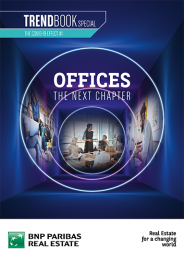Remote working will not be the end of the office building. Hybridisation was already in place in some buildings, and this is going to become the case for workspaces: flexible office space, working from home and third places. The office building gives rise to creativity, interactions, a sense of community, innovation and of course company culture. The headquarters is still the flagship of any company!

TrendBook Offices: the next chapter
What is life in our offices going to look like post Covid?
Take a deeper look at the trends, innovations and new ways of interacting with space that are going to affect our professional spaces.
The transformation of the office
Perhaps this idea of putting 7,000 people in a building is a thing of the past”. This short phrase uttered by the CEO of Barclay’s bank quite succinctly sums up the impact of Covid-19 on corporate real estate. Severely disrupting the organisation of workspaces, this unparalleled pandemic doesn’t signal the end for the office building, it has transformed and accelerated the shifts that have already been underway for many years.
Incidentally, if we believe the Yougov/Otka study, even in a flexible future, European employees are not willing to completely give up on the office and still appreciate their place of work: more than half of the people asked (57%) said that they miss face-to-face con-versations with their colleagues. Since, for a large majority of workers, coming to the office means belonging to a community. “Physical contact is part of the system that we use to establish our relationships, our friend-ships and our family allegiances” states Robin Dunbar, Emeritus Professor of Evolutionary Psychology at the University of Oxford.
It would seem that in this post-traumatic period, the office is proving itself more than ever to be the important cornerstone in fostering social bonds and the feeling of belonging for employees. Of course, it is evolving – in favour of the hybridisation of work premises (home, co-working, company premises) or its own hybridisation with spaces set up according to the function – but it remains an essential meeting place for clients, partners, service providers and employees who enjoy gathering for team meet-ings, discussions with colleagues and creativity.
The office space as a collaborative hub, company flagship, integral managerial tool and strategic leverage for organisations has still got a promising future ahead of it.




